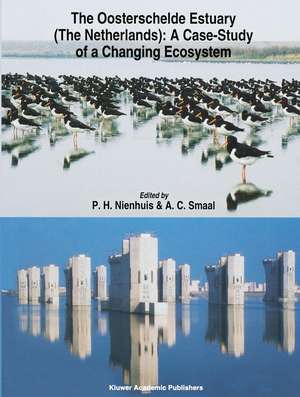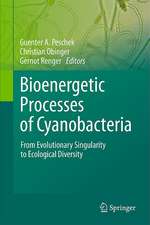The Oosterschelde Estuary (The Netherlands): a Case-Study of a Changing Ecosystem: Developments in Hydrobiology, cartea 97
Editat de P. H. Nienhuis, A.C. Smaalen Limba Engleză Paperback – 23 oct 2012
Owing to the broad interest in the meaning of the Oosterschelde estuary for Dutch and international societies, it became one of the most intensively studied coastal ecosystems in Western Europe. In an interdisciplinary approach of several state agencies and universities, a broad spectrum of physical, chemical and biological research has been carried out during the period of 1980--1989, dedicated to the structure and functioning of the saline ecosystem. The undisturbed estuary was studied during the period between 1980--1984. Large mathematical models had been constructed before 1986, to simulate future changes in the ecosystem. Further studies after the completion of the storm surge barrier (1986--1989) have been used for verification of the model. The integrated and summarized knowledge of the Oosterschelde ecosystem is used by water managers and nature and fisheries conservationists.
A case study for professional civil engineers, ecologists, marine biologists, water managers, decision makers, university students and anyone interested in physical, chemical and biological estuarine and coastal sciences.
Din seria Developments in Hydrobiology
- 18%
 Preț: 1229.10 lei
Preț: 1229.10 lei - 18%
 Preț: 959.98 lei
Preț: 959.98 lei - 18%
 Preț: 963.91 lei
Preț: 963.91 lei - 15%
 Preț: 648.24 lei
Preț: 648.24 lei - 15%
 Preț: 637.89 lei
Preț: 637.89 lei -
 Preț: 378.25 lei
Preț: 378.25 lei - 15%
 Preț: 644.95 lei
Preț: 644.95 lei - 18%
 Preț: 952.09 lei
Preț: 952.09 lei - 20%
 Preț: 558.87 lei
Preț: 558.87 lei - 18%
 Preț: 1833.65 lei
Preț: 1833.65 lei -
 Preț: 393.59 lei
Preț: 393.59 lei -
 Preț: 406.54 lei
Preț: 406.54 lei - 18%
 Preț: 1226.73 lei
Preț: 1226.73 lei - 18%
 Preț: 956.99 lei
Preț: 956.99 lei -
 Preț: 388.87 lei
Preț: 388.87 lei - 24%
 Preț: 1060.53 lei
Preț: 1060.53 lei - 18%
 Preț: 1229.28 lei
Preț: 1229.28 lei - 20%
 Preț: 569.31 lei
Preț: 569.31 lei -
 Preț: 368.79 lei
Preț: 368.79 lei - 24%
 Preț: 817.48 lei
Preț: 817.48 lei - 18%
 Preț: 958.25 lei
Preț: 958.25 lei - 18%
 Preț: 953.03 lei
Preț: 953.03 lei -
 Preț: 384.75 lei
Preț: 384.75 lei - 24%
 Preț: 1582.95 lei
Preț: 1582.95 lei - 24%
 Preț: 1051.70 lei
Preț: 1051.70 lei - 18%
 Preț: 943.57 lei
Preț: 943.57 lei - 18%
 Preț: 1235.76 lei
Preț: 1235.76 lei - 24%
 Preț: 800.05 lei
Preț: 800.05 lei - 24%
 Preț: 803.57 lei
Preț: 803.57 lei - 18%
 Preț: 948.29 lei
Preț: 948.29 lei
Preț: 430.72 lei
Nou
Puncte Express: 646
Preț estimativ în valută:
82.41€ • 86.06$ • 68.06£
82.41€ • 86.06$ • 68.06£
Carte tipărită la comandă
Livrare economică 11-17 aprilie
Preluare comenzi: 021 569.72.76
Specificații
ISBN-13: 9789401045124
ISBN-10: 9401045127
Pagini: 624
Ilustrații: XXIV, 597 p.
Dimensiuni: 195 x 260 x 33 mm
Ediția:Softcover reprint of the original 1st ed. 1994
Editura: SPRINGER NETHERLANDS
Colecția Springer
Seria Developments in Hydrobiology
Locul publicării:Dordrecht, Netherlands
ISBN-10: 9401045127
Pagini: 624
Ilustrații: XXIV, 597 p.
Dimensiuni: 195 x 260 x 33 mm
Ediția:Softcover reprint of the original 1st ed. 1994
Editura: SPRINGER NETHERLANDS
Colecția Springer
Seria Developments in Hydrobiology
Locul publicării:Dordrecht, Netherlands
Public țintă
ResearchCuprins
The Oosterschelde estuary, a case-study of a changing ecosystem: an introduction.- Theme I: Hydrodynamic and Geomorphological Changes in the Tidal System.- Hydrodynamic characteristics of the Oosterschelde in recent decades.- Changes in basin geomorphology after implementation of the Oosterschelde estuary project.- Fine sediments in the Oosterschelde tidal basin before and after partial closure.- Theme II: Structure and Functioning of the Pelagic System.- Turbidity, nutrients and phytoplankton primary production in the Oosterschelde (The Netherlands) before, during and after a large-scale coastal engineering project (1980-1990).- A new trend in the development of the phytoplankton in the Oosterschelde (SW Netherlands) during and after the construction of a storm-surge barrier.- Nutrient concentrations and planktonic diatom-flagellate relations in the Oosterschelde (SW Netherlands) during and after the construction of a storm-surge barrier.- Zooplankton species composition in the Oosterschelde (SW Netherlands) before, during and after the construction of a storm-surge barrier.- Zooplankton biomass in the Oosterschelde (SW Netherlands) before, during and after the construction of a storm-surge barrier.- Plankton size distributions and trophic relations before and after the construction of the storm-surge barrier in the Oosterschelde estuary.- Theme III: The Structure of the Benthic System.- Spatial and temporal patterns of intertidal macrobenthic populations in the Oosterschelde estuary: are they influenced by the construction of the storm-surge barrier?.- Microphytobenthos in the Oosterschelde (The Netherlands), 1981-1990; consequences of a changed tidal regime.- Composition, distribution and biomass of the meiobenthos in the Oosterschelde estuary (SW Netherlands).- Theeffects of prolonged emersion and submersion by tidal manipulation on marine macrobenthos.- Effect of sedimentological and hydrodynamical changes in the intertidal areas of the Oosterschelde estuary (SW Netherlands) on distribution, density and biomass of five common macrobenthic species: Spio martinensis (Mesnil), Hydrobia ulvae (Pennant), Arenicola marina (L.), Scoloplos armiger (Muller) and Bathyporeia sp..- Long-term changes (1979-89) in the intertidal macrozoobenthos of the Oosterschelde estuary: are patterns in total density, biomass and diversity induced by the construction of the storm-surge barrier?.- Changes in the sublittoral hard substrate communities in the Oosterschelde estuary (SW Netherlands), caused by changes in the environmental parameters.- Tidal reduction and its effects on intertidal hard-substrate communities in the Oosterschelde estuary.- Theme IV: Ecology of the Salt Marshes.- Changes in area, geomorphology and sediment nature of salt marshes in the Oosterschelde estuary (SW Netherlands) due to tidal changes.- Consequences of a tidal reduction for the salt-marsh vegetation in the Oosterschelde (The Netherlands).- The response of salt marsh vegetation to tidal reduction caused by the Oosterschelde storm-surge barrier.- Theme V: The Response of Benthic Suspension Feeders to Environmental Changes.- Mussel culture in a changing environment: the effects of a coastal engineering project on mussel culture (Mytilus edulis (L.)) in the Oosterschelde estuary (SW Netherlands).- Variability in stock assessment of cockles (Cerastoderma edule L.) in the Oosterschelde (in 1980-1990), in relation to environmental factors.- Biomass and standing stock on sublittoral hard substrates in the Oosterschelde estuary (SW Netherlands).- The role of the blue mussel Mytilus edulis in the cycling of nutrients in the Oosterschelde estuary (The Netherlands).- Theme VI: The Analysis of a Dynamic Simulation Model for the Oosterschelde Ecosystem.- SMOES: a Simulation Model for the Oosterschelde EcoSystem. Part I: Description and uncertainty analysis.- SMOES: a Simulation Model for the Oosterschelde EcoSystem. Part II: Calibration and validation.- Theme VII: The Higher Trophic Levels.- The mobile epifauna of the soft bottoms in the subtidal Oosterschelde estuary: structure, function and impact of the storm-surge barrier.- Changes in the fish fauna of the Oosterschelde estuary — a ten-year time series of fyke catches.- Changes in the waterbird populations of the Oosterschelde (SW Netherlands) as a result of large scale coastal engineering works.- Consumption of benthic invertebrates by waterbirds in the Oosterschelde estuary, SW Netherlands.- The harbour seal, Phoca vitulina, in the Oosterschelde: decline and possibilities for recovery.- Historical population size of the harbour seal, Phoca vitulina, in the Delta area, SW Netherlands.- Theme VIII: The Oosterschelde Estuary: An Evaluation of Changes.- Policy planning in the Oosterschelde estuary.- The Oosterschelde estuary: an evaluation of changes at the ecosystem level induced by civil-engineering works.- General index.
Recenzii
`The book is a must for everyone interested in and working on integrated water management. Those interested in the environmental effects of dam construction are provided with an essential reference work. Finally, the growing discussion on the impacts of sea-level rise due to global change can be stimulated by the results of this outstanding piece of research.'
International Journal of Environment and Pollution, 5:4-6, 1995
International Journal of Environment and Pollution, 5:4-6, 1995














